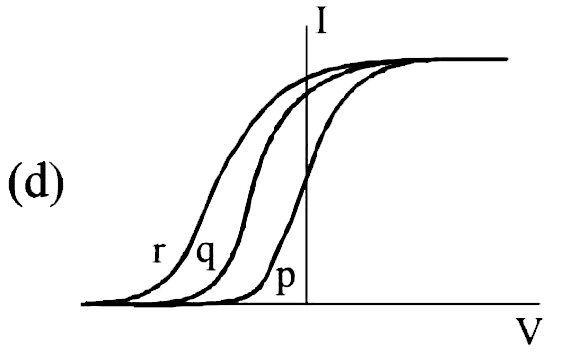Photoelectric effect experiments are performed using three different metal plates p,q andr having work function ϕp=2.0eV,ϕe=2.5eVandϕr=3.0eV respectively A light beam containing wavelength of 550nm,450nm and 350nm with equal intensities illuminates each of the plates . The correct I−V graph for the experiment is [Take hc = 1240 eV nm]
_E01_320_O01.png)
_E01_320_O02.png)
_E01_320_O03.png)
_E01_320_O04.png)
The correct Answer is:A
550 nm light cannot emit electron for metal of work function ϕ=3eV, so saturate current decreases for P to Q to R. Also |Vsp|>|Vsq|>|Vsr|
Topper's Solved these Questions
- BOOK - ALLENCHAPTER - SIMPLE HARMONIC MOTIONEXERCISE - MCQ s8videos
SIMPLE HARMONIC MOTION
- BOOK - ALLENCHAPTER - SIMPLE HARMONIC MOTIONEXERCISE - Comprehension #13videos
SIMPLE HARMONIC MOTION
- BOOK - ALLENCHAPTER - SIMPLE HARMONIC MOTIONEXERCISE - Exercise-04 [B]105videos
SIMPLE HARMONIC MOTION
- BOOK - ALLENCHAPTER - RACEEXERCISE - Basic Maths (Wave Motion & Dopplers Effect) (Stationary waves & doppler effect, beats)25videos
RACE
- BOOK - ALLENCHAPTER - TEST PAPEREXERCISE - PHYSICS4videos
TEST PAPER
Similar Questions
Find the threshold wavelengths for photoelectric effect from a copper surface, a sodium surface and a cesium surface. The work functions of these metals are 4.5 e V, 2.3 eV and 1.9 eV respectively.
View SolutionThree photo diodes D1D2andD3 are made of semiconductors having band gaps of 2.5 eV, 2 eV and 3 eV respectively. Which of them will not be able to detect light of wavelength 600 nm ?
View Solution
Knowledge Check
- Question 1 - Select One
photoelectric affect experiments are performer using ther different medal plates p,q andr having work functionphi_(p) = 2.0 eV, phi_(e) = 2.5 eVandphi_(r) = 3.0 eVrespectivelyAlightbeamconta∈∈gwave≤n>hof550nm , 450 nmand350nm withequal∫ensitiesilluminateseachoftheplate.Thecorrect1 -Vgraphfortheexperimentis [Take hc = 1240 eV nm]
A B
B C
C D
D
- Question 2 - Select One
Photoelectric effect experiments are performed using three different metal plates p,q and r having work functions ϕp=2.0eV,andphi_q=2.5eV andphi_(tau) =3eV and wavelengths of 550 nm,550nm, and 350 nm with equal intensities , illuminates each of the plates . The correct I - V graph for the experiment is (Take hc = 1240 eV nm)
A B
B C
C D
D
- Question 3 - Select One
Three metals A B and C have work functions as 15.5eV, 24eV and 30.5 eV respectively. If the light of wavelength 500Å is incident of each metal, which of the following is correct?
AElectrons can be ejected from A and C onlyBElectrons can be ejected from A and B onlyCElectrons can be ejected from A,B and CDNone of the above
Three photo diodes D1,D2andD3 are made of semiconductors having band gaps of 2.5 eV, 2eV and 3eV respectively. Which of them will not be able to detect light of wavelength 600 nm?
View SolutionThe graph between 1/λ and stopping potential ( V ) of three metals having work functions ϕ1,ϕ2 and ϕ3 in an experiment of photoelectric effect is plotted as shwon in the figure. Which of the following statement (s) is / are correct ? [Here λ is the wavelength of incident ray ].
 View Solution
View Solution(a) In a photoelectric experiment, the collector plate is at 2.0V with respect to the emitter plate made of copper (ϕ=4.5eV) . The emitter is illuminated by a source of monochromatic light of wavelength 200 nm. Find minimum and maximum kinetic energy of the photoelectrons reaching the collector.
(b) A small piece of cesium metal (ϕ=1.9eV) is kept a distance of 20 cm from a large metal plate having a charge density of 8.85×10−9C/m2 on the surface facing the cesium piece. A monochromatic light of wavelength 400 nm is incident on the cesium piece. Find minimum and the maximum kinetic energy of the photoelectrons reaching the large metal plate. Neglect any change in the electric field due to the presence of small piece of cesium.View SolutionThe photons from the balmer series in Hydrogen spectrum having wavelength between 450nm to 700nm are incident on a metal surface of work function 2eV find the maximum kinetic energy os ejected electron (Given hc = 1242 eV nm)
View SolutionLight of wavelength 350 nm falls on a metal having work function of 2eV. What is maximum possible magnitude of linear momentum of ejected electron ?
View Solution

